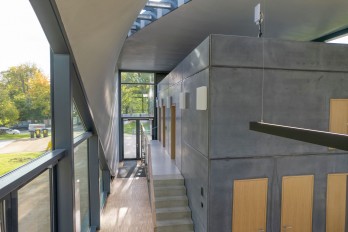New method to transform construction waste into useful materials

A group of German researchers has found a way to manipulate construction waste by turning them into new materials.
Construction industry is highly developed in Germany, a country that handles about 100 billion metric tons of material waste. Scientists from 4 Fraunhofer Institutes are now investigating the potential of recycling fine-grained building rubble.
A method, called the BauCycle process, which separates the rubble's components using an opto-pneumatic detector has been developed. Under certain conditions, BauCycle can process about 1.5 metric tons per hour. Fine fractions are distinguished by color, brightness and chemical procedures. "The waste components are placed on a conveyor belt that transports them past an infrared camera equipped with special filters to detect the various fine fractions. The particles drop off the end of the belt in free fall, past nozzles that shoot the main components into different containers with targeted blasts of compressed air," says Fraunhofer IBP scientist Dr. Volker Thome, the project's manager.
The purpose of the project is to create a component deposit made of construction waste that could be utilized in various applications and be recycled into construction industry. For example, geopolymers, a building material with lower carbon footprint than concrete, can be produced by mixing bricks and such components. Additionally, aerated concrete, a lightweight, precast, foam concrete material with good thermal insulation can also be produced using those separated components.
Business plans to invest in a recycling material market still lack confidence but efforts are made to improve the situation. "Recycled products have yet to be sold on established markets. There is a lack of confidence in and knowledge of these secondary raw materials. We want to close this gap with a commodities exchange," Dr. Thome stated.
Sources: Phys.org, Newcivilengineer.com
Want to read more like this story?

10 state-of-the-art sustainable materials that will alter construction industry
Jun, 10, 2024 | NewsIn 2024, sustainable materials become state-of-the-art in construction since the construction indus...

Sustainable materials can be used in construction to decrease environmental pollution
Apr, 30, 2024 | NewsEfforts to reduce emissions in the building sector typically focus on operational aspects like heat...

Zero-cement concrete will reduce the environmental impact in construction industry
Aug, 08, 2024 | NewsDue to the climate crisis and the high CO2 emissions of concrete, engineers and scientists are seek...
Concrete Structures
Jan, 01, 2019 | EducationConcrete structures are constructions that utilize concrete as the primary building material. Conc...
Composite structures
Sep, 07, 2023 | EducationComposite structures refer to constructions that are composed of two or more distinct materials co...

Smart construction: How superstructures are built in just 11 days
Mar, 06, 2025 | NewsThe construction industry has undergone significant changes in recent years as digital transformati...

Building walls with demolition waste - the poetry of Cyclopean concrete
Sep, 16, 2022 | NewsAncient cyclopean walls were built by overlapping raw stones, supported one on the other, without t...

Organic London Skyscraper Concept Unveiled
Jul, 10, 2014 | NewsFrench architectural firm Chartier-Corbasson has joined in on the green structures trend by unveilin...

The world’s first carbon concrete building constructed by researchers in Germany
Nov, 10, 2022 | NewsThe first building made of carbon-reinforced concrete was inaugurated in September after two and a...
Trending

Spectacular interchanges around the world

New Release - STAAD.Pro 2024 - 2

ADINA 2025 for Structural WorkSuite

ADINA 2025 New Release!

Drilled Shafts Project on Gilbert Road Bridge

Powerful earthquake shakes central Philippines, dozens killed

Partial collapse of apartment building in NYC due to blast loading

